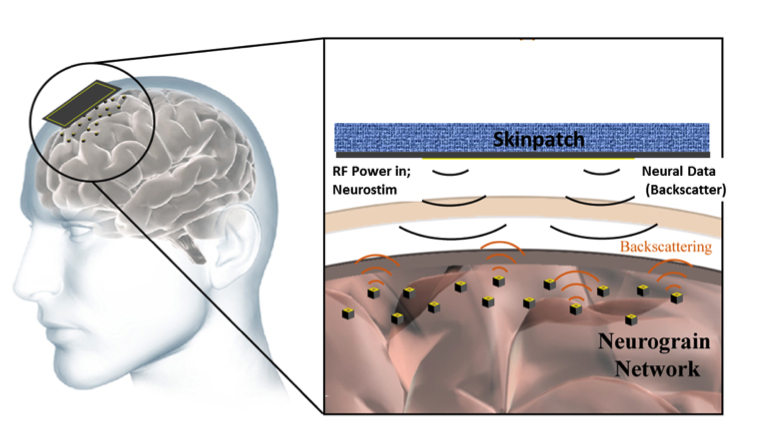News Release
UC San Diego part of international team to develop wireless implantable microdevices for the brain
Engineering faculty to receive nearly $4 million for subcontract on DARPA project
San Diego, Calif., July 11, 2017 -- Engineers at the University of California San Diego are part of an international collaboration led by Brown University to develop a wireless neural prosthetic system that could record and stimulate neural activity with unprecedented detail and precision. Researchers envision that the wireless neural prosthetics could lead to new medical therapies for people who have lost sensory function due to injury or illness.
The research team also includes research team along with IMEC (a Belgian microtechnology institute), Massachusetts General Hospital, Stanford University, UC Berkeley, Qualcomm Inc. and the Wyss Center for Bio and Neuroengineering in Geneva. The overall project is funded by the Defense Advanced Research Projects Agency (DARPA) through its new Neural Engineering System Design (NESD) program.
The project aims to create a "cortical intranet" of tens of thousands of wireless micro-devices — each about the size of a grain of table salt — that can be safely implanted onto or into the cerebral cortex, the outer layer of the brain. The implants, dubbed “neurograins,” will operate independently, interfacing with the brain at the level of a single neuron. The activity of the devices will be coordinated wirelessly by a central communications hub in the form of a thin electronic patch worn on the skin or implanted beneath it.
The system will be designed to have both “read-out” and “write-in” capabilities. It will be able to record neural activity, helping to deepen scientists’ understanding of how the brain processes stimuli from the outside world. It will also have the capability to stimulate neural activity through tiny electrical pulses, a function researchers hope to eventually use in human clinical research aimed at restoring brain function lost to injury or disease.
 |
| The new system will use microdevices to both "read out" and "write in" neural information. Image courtesy of Brown University |
“What we’re developing is essentially a micro-scale wireless network in the brain enabling us to communicate directly with neurons on a scale that hasn’t previously been possible,” said Arto Nurmikko, the L. Herbert Ballou University Professor of Engineering at Brown University and the project’s principal investigator. “The understanding of the brain we can get from such a system will hopefully lead to new therapeutic strategies involving neural stimulation of the brain, which we can implement with this new neurotechnology.” Nurmikko’s team will focus on decoding neural processing of speech, notably the tone and vocalization aspects of auditory perception.
The grant to Brown University totals up to $19 million. Of that, nearly $4 million will go to UC San Diego under a subcontract with electrical engineering professor and Qualcomm Institute director Ramesh Rao as principal investigator. “UC San Diego has a major role to play in creating what is essentially a micro wireless communications network for the brain to transmit and receive signals between individual neurons and the digital world,” said Rao. “This project leverages our university’s cutting-edge leadership in wireless communications, circuit design and neuroscience, and we have long-standing partnerships with other research teams on the DARPA project.”
Engineering faculty undertaking the research at UC San Diego will include electrical engineering professors Peter Asbeck and Patrick Mercier, as well as Institute for Neural Computation co-directors Terry Sejnowski (a professor at the Salk Institute and and faculty-affiliate in the Department of Computer Science and Engineering) and Gert Cauwenberghs (a bioengineering professor at the UC San Diego Jacobs School of Engineering).
Researchers from the Jacobs School will focus on designing analog and wireless electronics for the ‘neurograin’ microchips that are a critical part of the overall system under development.
“The cortical intranet linking neurograins in the brain will be designed to have both ‘read-out’ and ‘write-in’ capabilities,” said Mercier. “It will be able to record neural activity, helping to deepen scientists’ understanding of how the brain processes stimuli from the outside world.”
The network will also have the capability to stimulate neural activity through tiny electrical pulses – a function that researchers hope to eventually use in human clinical research aimed at restoring brain function lost to injury or disease.
Other key personnel on the project include UC San Diego alumnus Vincent Leung (Ph.D. ’12), who runs the Circuits Labs in the institute, where much of the technology on the DARPA project will be tested. Leung’s Ph.D. advisor at UC San Diego was former electrical engineering professor Larry Larson, who is now at Brown University and is a co-PI on the main DARPA grant.
The UC San Diego researchers will participate in three of the DARPA project’s five major tasks. One is the neurograin layer, which involves microfabrication of the sub-millimeter and implantable microsensors. Second is the telecom layer, which features the head-mounted ‘skinpatch’ with ultralow-power RF electronics and a subcutaneous hub optimized for network communication. “The skinpatch becomes the de facto wireless base station for transmitting and receiving signals,” explained Mercier. “In doing so, it powers the neurograins and serves as the hub for relaying data to and from an external command center that transcodes and processes neural and digital signals.”
The third major task involves the decoding/encoding layer and its implementation as a body-wearable neural signal processor with decoding/encoding algorithms and computational hardware.
The remaining two major tasks of the project will be spread out among researchers at Brown University and subcontractors affiliated with the other collaborating teams.
DARPA’s NESD program aims to develop new devices that will be able to “provide advanced signal resolution and data-transfer bandwidth between the brain and electronics.”
Media Contacts
Doug Ramsey
Jacobs School of Engineering
858-822-5825
dramsey@ucsd.edu
Liezel Labios
Jacobs School of Engineering
858-246-1124
llabios@ucsd.edu